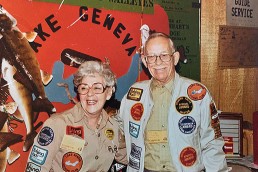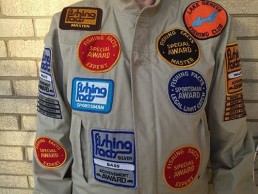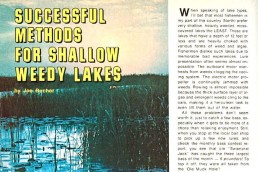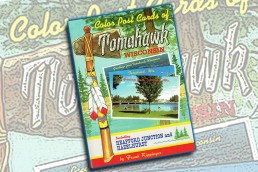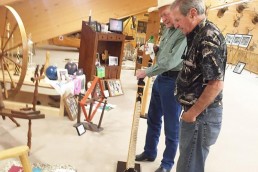Fishing Facts Jacket Unlocks History
SHARE THIS POST
While acquiring some old fishing tackle from a gracious 97-years-young widow recently, she showed me her late husband’s fishing jacket. It was covered with Fishing Facts award patches that she planned to remove before donating the jacket to Goodwill.
Many times, as we work to collect, preserve and share old fishing items and their history, we find too late that our greatest competitor, the trash man, has taken these items to the dump, and pieces of our outdoor sports’ heritage are lost for all time. This time would be different, as we explained how we wished to write the story of this important artifact and share it in exhibits.
A great fishing couple
In many visits with Bernice Stevo Schweikler, I was very impressed with her graciousness, vitality, enthusiasm and artistic talents. Her story is one of a woman who has lived through tough times and has persevered with a great, positive, friendly attitude.
Her father died in an auto accident when she was just 5 1/2 years old. Her mother then put her in a day nursery while she worked. They tried to force her to eat oatmeal, but she kept saying, “No thank you.” They threatened to put her in the baby nursery. Bernice responded, “I’ll wake up every baby.”
The next day she had the boys push the slide in the exercise yard by the fence so she could climb the steps and escape. She had counted the houses on the way to daycare, so she had no trouble finding her way home.
Her mother then took her for care to her godmother who lived right on Fox Lake in northern Illinois. This was paradise as a priest roomed there and taught her how to catch, clean and prepare fish.
After graduation, she modeled for the Florsheim Shoe Company, and then worked at a gift shop in Logan Square. This was a very close-knit community where people worked, shopped, ate and recreated together. People kept pushing her to get together with Willis “Red” Schweikler whose mother had died when he was 5 years old.
Red worked at a Logan Square haberdashery and was crazy about fishing. In fact, his wealthy father had offered to buy him an auto dealership, fishing resort and other businesses, but Red said it would take too much time away from fishing. Eventually he became a car salesman, so he had the freedom to go fishing a lot.
Bernice and Red wed November 21, 1941 after dating for 30 months. She was 25 and he, 31. Her father-in-law warned her that Red had a bad heart and would be lucky to live past 50. He built them a home next door to his and also advised her, “Learn to fish good or this marriage wont last a year.”
Red’s bad heart kept him out of WWII, and in an era of food shortages and rationing, their fishing and hunting provided sumptuous meals.
Buck Perry came to Chicago in 1957 and stunned the Midwest with his catches from fished out waters. People like Ron and Al Lindner, Bill Binkelman and more began a fishing revolution. Terms like “structure” and tools that included Fish Lo-K-Tors began to unlock innovations in our sport.
Are you enjoying this post?
You can be among the first to get the latest info on where to go, what to use and how to use it!
The Schweikler’s joined the Lake Geneva Fishing Club, studied fishing and fished a lot, many times on the same lake as Binkelman. They were part of this era of fishing discovery and subscribed to the Fishing News that Bill Binkelman of Milwaukee’s Boston Store produced.
Driving to regular club meetings in Lake Geneva was no problem; they loved it. On their trips up north, it was common to stop by the Boston Store to visit with Binkelman and resupply their stock of Crawford Jigs and other tackle items.
The Fishing News made a major announcement with their special 12-page June 1968 issue. By then, George Pazik had become the Publisher and the name was changed to Fishing Facts and Secrets. Other changes included going from 4 pages to a permanent 8-page publication. The single issue price was increased from 25 to 35 cents and subscriptions went to $3 for one year and $5 for two years.
Up to that time, neither Pazik nor Binkelman had taken any pay for all of their work. They only had 15 cents left over after producing and mailing a two-year subscription. It was an exciting time, when we loved learning and sharing and gave little thought to money.
One of their previous announcements was a revision of their Big Fish contest that had issued trophies to readers who made big catches using their revolutionary baits and methods. So many trophies were won in 1967 that Bill wrote, “The point has been made—you can do it, our methods work—and so the Big Fish contest is no longer needed. You proved it to us.”
Cards, letters, phone calls and personal visitors protested! Readers wanted the contest to remain, but agreed to a lower, more affordable program.
The new rules were such that a first qualifying lunker fish was awarded a “Fishing Facts Expert” patch and a certificate. For four or more lunker fish entries, a “Fishing Facts Master” patch and certificate were won. Eligible fish included largemouth bass, smallmouth bass, walleye, northern pike, catfish, lake, rainbow, brook and brown trout, musky and coho. The contest ran from March 30 through October 31, 1968. Over the years, awards were refined and the Schweikler’s won many of them, wearing their jackets proudly.
Red and Bernice’s jackets testify to the success learned and earned through Fishing Facts. In April of 1984, Red’s heart was failing. He agreed to an experimental operation to replace a heart valve with that of a pig. Five days later, he passed away, but what was learned has helped heart health today. Bernice then learned to drive and continued to fish and be involved with the Lake Geneva club.
We enjoy reviewing the past while looking forward to the future and the excitement of new destinations, lures and methods we will share to help increase your enjoyment of the great outdoors.
Dan Basore is a fishing historian and steward of the history of the sport. In his efforts to preserve fishing history, Basore is always on the lookout for information about early lure makers, old lures, pre- level wind reels, manufacturer catalogs, tournament casting items and the like. If you possess information or materials that can help, please contact Dan Basore, Historical Fishing Display, at 630-393-3474 or 1-800-347-4525.
MWO
SHARE THIS POST
Did you enjoy this post?
You can be among the first to get the latest info on where to go, what to use and how to use it!
Dan Basore
Dan Basore is a fishing historian and steward of the history of the sport. In his efforts to preserve fishing history, he is always on the lookout for information about early lure makers, old lures, pre-level wind reels, manufacturer catalogs, tournament casting items and the like. If you possess information or materials of this kind, please contact him at 630-393-3474 or by email at ollures@aol.com.
